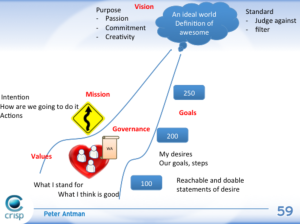Anti-Agile är en av mina favoritövningar att facilitera vid uppdrag hos kund. Använder man denna övningen internt inom en organisation så synliggör man ofta många dysfunktioner som finns inom organisationen; kulturellt, strukturellt och hur man arbetar. Övningen fungerar också väldigt bra som en murbräcka i att bryta tron att allt fungerar så bra som det är, och föreställningen att vi är så agila som vi möjligen kan bli. Det senare är många gånger en utmaning då en stark föreställning om sin egna förträfflighet är ett stort hinder att ta sig över som coach för att få kunder att öppna upp sig för coaching och vägledning i sin arbetssituation.
Bootstrapping a Working Agreement for the Agile Team
I suspect that running a session with a team to help them bootstrap a Working Agreement, is the single most common workshop I’ve been facilitating the last couple of years. And I’ve learned a lot of what works for me (and what doesn’t work). In my experience, this approach works equally well for the agile team, the department management group and the steering board team. This blog is me documenting how I ended up facilitating these sessions.

For me, a Working Agreement captures the expectations we have on each other within the team when we collaborate and communicate. I’ve seen teams call it “Code of Conduct” or “Ways of Working”. I call it Working Agreement. You call it whatever makes sense for you.
Running a Working Agreement workshop as early as possible is crucial for setting the team up for success. Preferably it’s done during the team’s two-day kick-off offsite, or at least within the first few weeks as a planned structured workshop.
New book being written online – Facilitation tricks and techniques
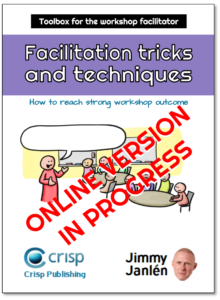 Last time I wrote a book (Visualization Examples) I decided to do it publicly online. That was a fantastic experience, which I also wrote a blog post about. It was great fun and I got tons of valuable feedback.
Last time I wrote a book (Visualization Examples) I decided to do it publicly online. That was a fantastic experience, which I also wrote a blog post about. It was great fun and I got tons of valuable feedback.
Now I’ve started to write a new book and I’ve decided to have the same approach. It’s currently titled “Toolbox for the workshop facilitator – Facilitaion Tricks and Techniques (How to reach strong workshop outcome)“.
The book is far from finished and it might take me another year to finish it. But I still want to invite you to read it now and to help me make the book even better.
Facilitate a project retrospective
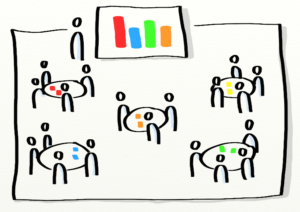 Large group retrospectives are long, large, unwieldy facilitations. So much so that they’re typically done only at the end of a project. Holding a 1-2 day retro every few weeks for a large project is neither practical nor responsible, but continually improving the project is also important. So, how do you hold light-weight retrospectives for large groups, while making sure that you:
Large group retrospectives are long, large, unwieldy facilitations. So much so that they’re typically done only at the end of a project. Holding a 1-2 day retro every few weeks for a large project is neither practical nor responsible, but continually improving the project is also important. So, how do you hold light-weight retrospectives for large groups, while making sure that you:
- Have a common understanding
- Identify issues and strengths
- Reach a group agreement on action points
- Ensure that the group feels that they received a high return on time invested
This retrospective combines different techniques and technologies to achieve these results.Continue reading
The Pirate Ship – Growing a great crew: a workshop facilitation guide
The Pirate Ship is a workshop format that will help you grow amazing teams. It is “speed boat” on steroids. I have now been using it for a couple of years, and the time have come to share this useful and productive format.
I do a lot of workshops with teams. Very often the workshops are about the teams themselves. It can be anything from getting a newly started team up and running to helping a mature and stable team find new inspiration and challenges.
The Agile Meetings Cube
Agile facilitators, be aware, now you are about to be replaced – by a cube. Just kidding. But have you ever felt that your meetings are not on track? Or that you have a hard time doing the elevator pitch for that backlog grooming meeting you would like your team to have? Or do you meeting often ends in thin air? Comes your rescue: The Agile Meeting Cube.
The Agile Meeting Cubes gives you purpose, expected outcome and a suggested checklist and possible tools to use for six classical Agile or Scrum Meetings:
- Release Planning
- Backlog grooming
- Sprint Planning
- Daily Standup
- Sprint Review
- Sprint Retrospective
Download it from conceptcubes.com and do the following:
Continue reading
My Spotify tools
Last week i quit my assignment at Spotify. I was there to help and act as a stand-in for Joakim Sundén while he was on paternity leave. He’s now back in the saddle as Agile Coach in the More Than Music Tribe. I had the pleasure to work closely with the Agile Coach Christian Vikström on Spotify and together we have been coaching the Browse, Growth and Customer Support squads. A was also a member of the tribe management team, and together we did some new interesting stuff.
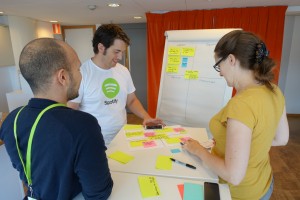
It’s has been fascinating and fantastic to work with such dedicated people and a product that has such a traction. Spotify is also really trying to build an awesome and agile organization and culture that can win and sustain in the long run. What is there to do at such a fantastic company? That’s a reasonable question. A lot I discovered. Spotify is shock full of super smart people, but many of them has not worked there for long, many of them has not worked long at all, teams have been newly formed and are under constant change. Simply put: even Spotify needs a lot of basic agile coaching.
When I now look back at what we did during these last 8 month I see a lot of tools and experiences that I think others also can find useful. During the next couple of month I will share them through this blog. Hope you will find them useful. Here’s the planned list:
Facilitating from the Back of the Room at Spotify
Last week Jimmy Janlén and I held a shortened version of our course Training from the Back of the Room for our former colleagues at Spotify. Actually it is not “our” course, but Sharon Bowmans. It’s based on her books about how create a more engaging learning experience in the class room, especially when training adults.
“I really liked the whole setup of this course – a really well organised and inspiring day. Wow :-)”
Jimmy and I are certified trainers of this course. We use the techniques when we do training. But we have also experienced how useful they are in other coaching and facilitation situations, such as workshops and retrospectives. Almost any meeting can be made more engaging and with longer lasting result with the set of tools TBR provides.
We have chosen to call the shortened training Facilitating from the Back of the Room, since that is what we agile coaches do most. 16 persons from the Spotify Agile Guild showed up this beautiful day in a corner room on the 17:th floor in High Tech building with amazing views over Stockholm city. We have to admit we were a little nervous at first. Would this actually make sense to coaches? It did.
Learning flow with the Lean Dot Game
Yesterday we had one of our regularly occurring so called Agile Lunch & Learn in the tribe at Spotify I currently work. We wanted to make the lunch about why it is often better not to work and focus on flow than to maximize your work and focus on resource efficiency. I searched for something in the Crisp bag of games. Pass the pennies – more about big batches. Kanban tothpicks – to many rounds and variables. Folding envelopes – again more batches. Eventually I found the Lean Dot game.

What a find! This game will be with me for a long time. The best flow game there is, with extremply simple props: post-it notes and colored dots. You can run it in an hour and get tons of experiences and stuff to discuss, such as:
- Why it’s better to slow down
- Adapt to bottlenecks
- Batch sizes
- Little’s law illustrated
- Waste and inventory
- Customer collaboration
- In process testing
- And more, and more, and more…
Crisp consensus model 2.1
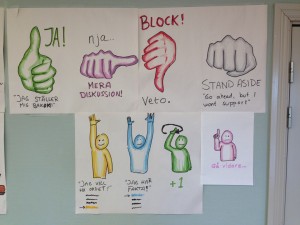
At Crisp we try to use consensus when making important decisions. Why do we do that?
Crisp is a very flat company. Most of us have no boss and report to no one. Basically you can be part of Crisp in two ways: either you have your own firm and have a partner contract with Crisp (all consultants have this) or you are employed by Crisp (administrative personnel). Crisp is owned by most (but not all) of the members/partners. The owners have, however, renounced their right to run the company (from all but legal necessities). This means that the company is run by all partners and employees with an equal vote each. We no longer have a CEO and we elect our board. This means we have to have good ways of making decisions together. And consensus is a very good way of making decision in a flat group like ours.
